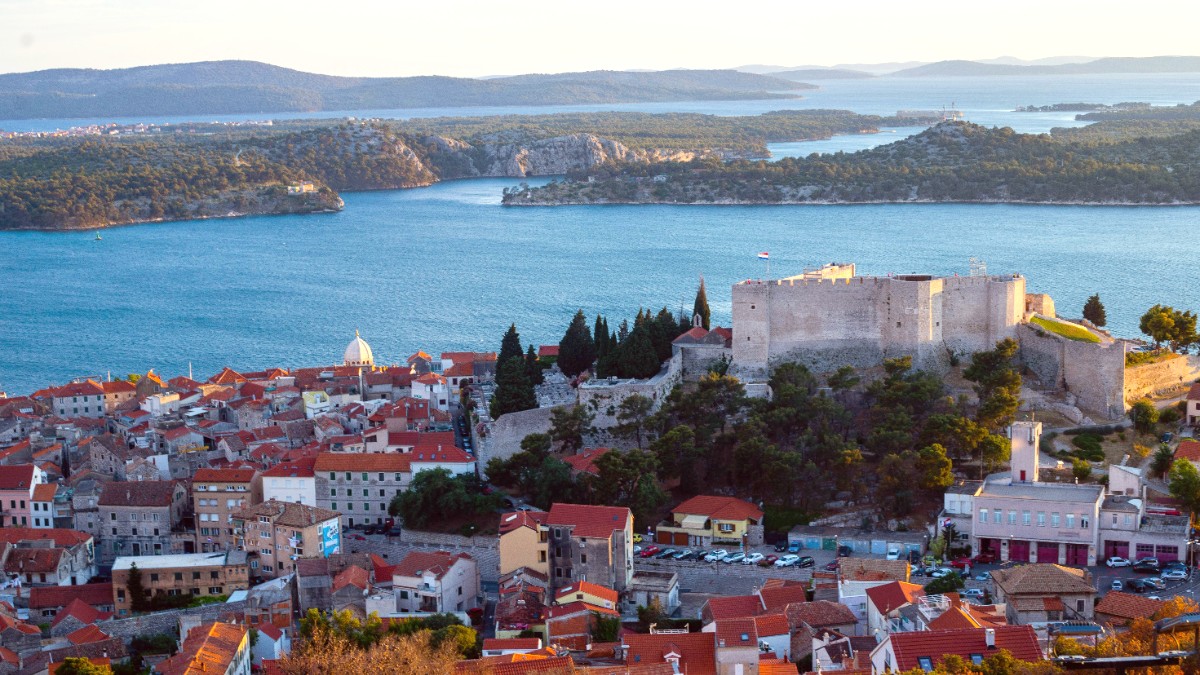
Croatia
Šibenik's cuisine is deeply rooted in Dalmatian culinary traditions, sharing similarities with Mediterranean food. Influences from Italian and, to a lesser extent, Greek cooking are present, with subtle echoes of Ottoman and Austro-Hungarian history in some dishes. Local cooking emphasizes fresh, seasonal, and locally sourced ingredients, which results in simple preparations where the quality of raw materials shines. Olive oil is a staple, used generously.
ingredients include fresh fish and seafood (white fish, octopus, squid, mussels), high-quality extra virgin olive oil, garlic (an ubiquitous flavor), herbs (rosemary, sage, parsley, bay leaves), and seasonal vegetables (tomatoes, zucchini, eggplant). Meat, like lamb and veal, is popular, often slow-cooked. Local prosciutto (pršut) is a beloved appetizer, as is Paški sir, a famous sheep's milk cheese from Pag island. Homemade pasta and gnocchi are frequently served.
Simply grilled, especially fish and seafood, with olive oil and fresh herbs.
Boiled, often referring to boiled fish or vegetables.
Slow-cooked under a bell-shaped lid, covered with embers. This traditional method makes meat or octopus tender and flavorful. Order in advance. See image of Peka dish.
Meat (lamb or octopus) and vegetables slow-cooked under a bell-shaped lid. Exceptionally tender and flavorful. Find at traditional konobas; order in advance.
A truly authentic Croatian culinary experience.
A rich, savory risotto colored and flavored with squid ink, typically with squid or cuttlefish. Common at seafood restaurants.
A visually striking and delicious seafood favorite.
Pašticada: Traditional Dalmatian beef stew, slow-cooked in a rich sweet-and-sour sauce, often with prunes, served with homemade gnocchi. Brodet: A rich fish stew, often with various fish and seafood, served with polenta.
Hearty and full of regional flavors.
Burek: Savory pastry with meat, cheese, or spinach, found at bakeries. Ćevapi: Grilled minced meat sausages served in flatbread with onions and ajvar.
Fritule: Small fried doughnuts. Rožata: Dalmatian crème brûlée with rose liqueur. Šibenik Cake: Local specialty with almonds, chocolate, figs, spices.
Upscale restaurants showcase modern Croatian cuisine with fresh, local ingredients and creative presentations. Many feature stunning sea views. Reservations are often appropriate.
Numerous konobas (traditional taverns) and casual restaurants. Grilled meats, fresh fish, pasta, and risottos in a relaxed setting. Good places for authentic Dalmatian dishes.
Bakeries (pekara) for burek and pastries. Pizza parlors for quick meals. Fast food serves ćevapi. Small cafes have coffee and sandwiches. Šibenik Market (Tržnica) and Fish Market (Ribarnica) for fresh produce and seafood.
Vegetarian options are growing. Look for grilled vegetables, salads, and meat-free pasta dishes. Vegan options need clear inquiry; explain your needs. Carry a Translation card to communicate clearly.
Best to look for specific restaurants online beforehand.
Awareness about gluten-free and other allergens is growing. Carry a translation card for clarity. Larger, modern restaurants may be more accommodating than traditional konobas. Supermarkets carry some gluten-free products.
Halal and Kosher availability is very limited; self-catering and clearly labeled products are the best approach.
Learn Dalmatian cuisine.
Olive oil, wine, and cheese tastings.
Seasonal events celebrate local bounty.
Gastronomic experiences at historic sites.
Numerous Konobas (traditional taverns) offer grilled meats, fresh fish, pasta, and risottos. Relaxed settings are common for authentic Dalmatian dishes.
Excellent for a taste of local favorites.
Casual restaurants are abundant. A limited but growing number of international restaurants appear, mainly Italian (pizza and pasta), with some Asian or other ethnic options.
Wide array of choices for varied tastes.
A daily market near the waterfront. Find fresh fruit, vegetables, local cheeses, olive oil, and souvenirs. A lively atmosphere offers a glimpse into local life.
Located next to the main market, it features freshly caught seafood in the mornings. You can buy fish directly from the fishermen, a worthy sight.
Some local tour operators or private chefs present cooking classes focusing on Dalmatian cuisine, teaching peka or traditional seafood dishes.
Opportunities in surrounding rural areas to visit olive groves, wineries (Babić wine), or family farms (agroturizam). Many present tastings of local produce.
Various food-related events happen throughout the year, especially in summer. Look for wine festivals, olive oil tastings, or seafood fairs.
Dalmatian smoked ham (Pršut) and sheep's milk cheese from Pag island (Paški sir) are must-try appetizers, often with olives.
Ideal for a light start to your meal.
Freshly caught fish (sea bass, bream) simply grilled with olive oil, garlic, and parsley. This simple method allows the fresh flavor of the fish to stand out.
A staple at most seafood restaurants.
Seek out smaller konobas away from the main tourist paths for more authentic, often more affordable, dining.
Embrace the local coffee culture; lingering over a strong espresso is a way of life.
Learning a few basic Croatian phrases (e.g., "Hvala" for thank you) is always welcome.
Freshness is a cornerstone of Šibenik's cuisine. Ask for "riba prvog ulova" (fish of the first catch).